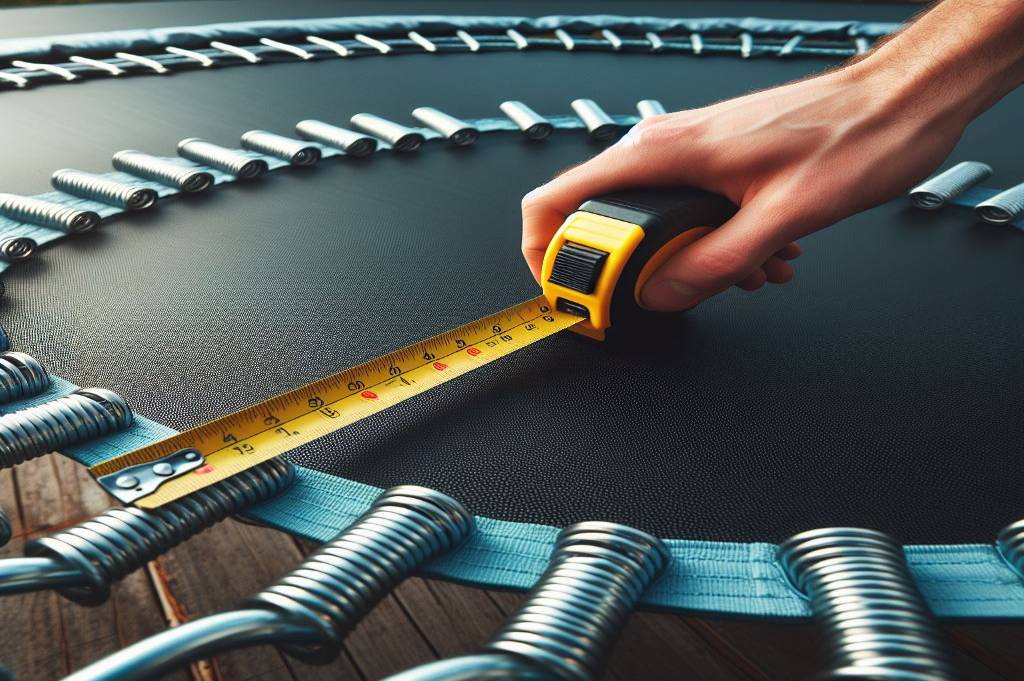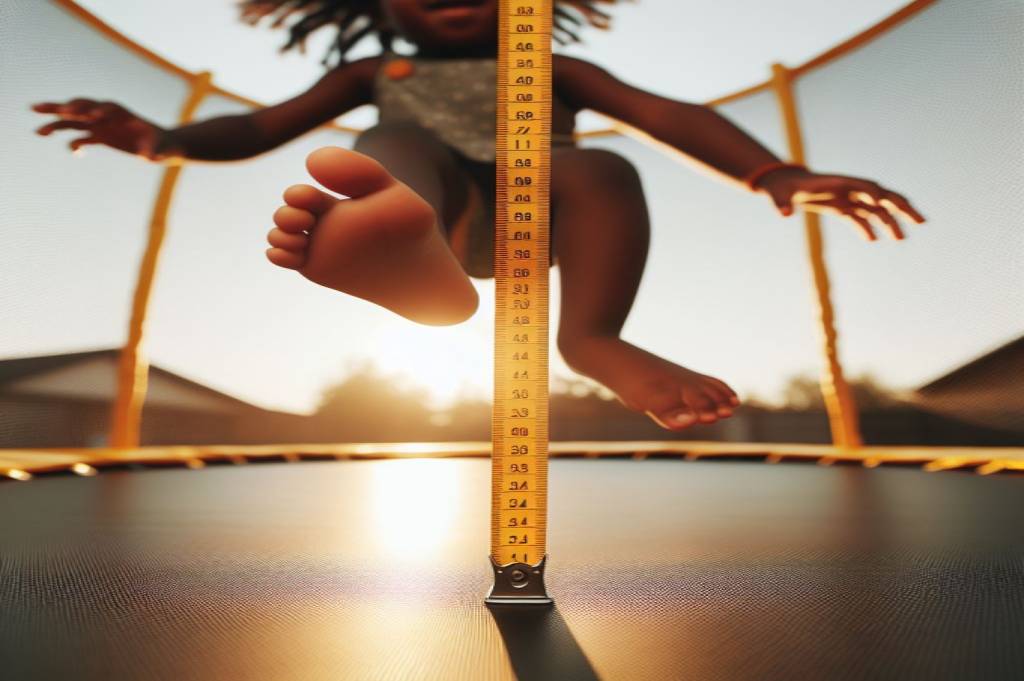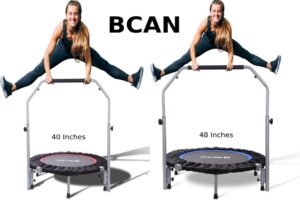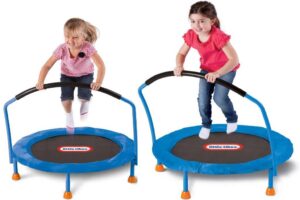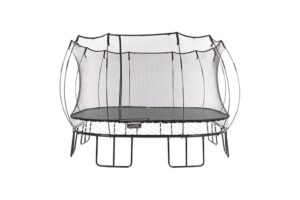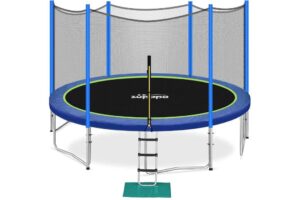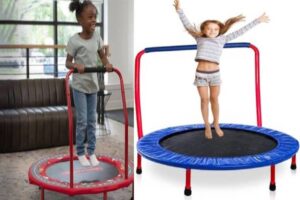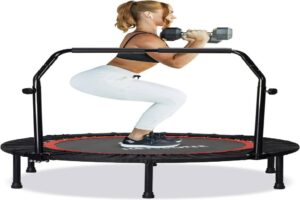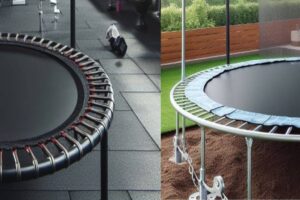Introduction
Welcome to our comprehensive guide on the critical process of measuring your trampoline. Whether you’re a new trampoline owner, looking to replace your current one, or simply ensuring that your current setup is safe and enjoyable, accurate measurements are key. Here, we’ll outline why precision in trampoline measurements matters, the vital intersection of safety and size, and how getting the right dimensions sets the stage for countless hours of bouncing joy.
Why Accurate Trampoline Measurements are Crucial
Before delving into the step-by-step process, it’s crucial to understand why accurate trampoline measurements are non-negotiable. The dimensions of your trampoline directly impact its performance, safety, and the overall enjoyment of the bouncing experience.
A trampoline that is too small may restrict movement, while one that is too large can pose safety risks. By taking the time to measure your trampoline correctly, you are investing in a foundation for optimal performance and safety.
The Intersection of Safety and Size
In the realm of trampolines, safety and size intersect to create the foundation for a secure and enjoyable bouncing experience. The dimensions of your trampoline directly impact its safety, with considerations such as frame size, jumping surface area, and weight capacity playing crucial roles in ensuring user safety.
A trampoline that is too small or lacks sufficient weight capacity may pose risks to users, leading to accidents or injuries. Conversely, a properly sized trampoline provides ample space for safe bouncing and accommodates users of all ages and sizes. By striking the right balance between safety and size, you create an environment where fun and security coexist harmoniously, allowing for countless hours of bouncing enjoyment for everyone involved.
Balancing Fun with the Right Trampoline Dimensions
While safety is paramount, we also recognize that the primary purpose of a trampoline is fun and enjoyment. The correct dimensions contribute to a balanced and harmonious bouncing experience. Whether it’s a solo jump session or a group activity with friends and family, the right trampoline size sets the stage for maximum enjoyment. As we guide you through the step-by-step process, keep in mind that the end goal is not just accuracy but the creation of a space where the joy of bouncing knows no bounds.
In the upcoming parts, we’ll break down the process into manageable steps, ensuring that you have the knowledge and tools needed to measure your trampoline accurately. Let’s embark on this journey together, where precision meets play, and the result is a trampoline perfectly tailored to your needs. Happy measuring!
Understanding the Importance of Accurate Measurements
The significance of accurate measurements cannot be overstated. We shed light on the pivotal role on precision that craft a trampoline experience with both safe and enjoyable. The critical role of precision explores how the exact dimensions of a trampoline influence its performance and user satisfaction. Moving forward to safety considerations in Measurement that underscores the direct link between accurate measurements and creating a secure bouncing environment. Delving deeper to maximizing enjoyment with the correct size that emphasizes the synergy between size and fun, illustrating that an appropriately measured trampoline ensures not only safety but also an optimal space for unrestrained joy.
The Critical Role of Precision
Precision plays a critical role in every aspect of trampoline setup, from measuring the frame to selecting the right springs. Accurate measurements ensure that your trampoline is set up correctly, maximizing safety and performance. A properly measured trampoline is more stable and durable, reducing the risk of accidents or injuries during use.
Additionally, precision in measurements contributes to an optimal bouncing experience, with the right frame size, jumping surface area, and spring tension providing a responsive and enjoyable bounce. By prioritizing precision in every step of the process, you can create a trampoline setup that meets your needs and exceeds your expectations, ensuring countless hours of safe and exhilarating fun for yourself, your family, and your friends.
Safety Considerations in Measurement
Safety considerations are paramount throughout the entire trampoline measurement process, ensuring a secure and enjoyable environment for users. When taking measurements, it’s essential to prioritize safety by clearing the area around the trampoline of any obstacles or debris that could pose a tripping hazard.
Additionally, ensuring that the trampoline is securely anchored to the ground and that the ground is level and stable minimizes the risk of accidents during the measurement process. When adjusting tension in springs or handling tools, wearing appropriate protective gear such as gloves and safety glasses adds an extra layer of safety.
By incorporating these safety measures into the measurement process, you can create a safe and secure trampoline setup that provides peace of mind for yourself and your loved ones.
Maximizing Enjoyment with the Correct Size
Maximizing enjoyment with the correct size of your trampoline is essential for creating an optimal bouncing experience. The dimensions of your trampoline, including the frame size, jumping surface area, springs and weight capacity, directly impact the quality of the bounce and the overall enjoyment of users.
A trampoline that is too small may feel cramped and restrictive, limiting the range of movements and reducing the fun factor. Conversely, a properly sized trampoline provides ample space for users to bounce freely and comfortably, accommodating individuals of all ages and sizes. By paying attention for the correct size of your trampoline, you can ensure that everyone can enjoy hours of safe and exhilarating bouncing fun, making memories that will last a lifetime.
Preparing Your Trampoline for Precise Measurements
Before embarking on the journey of measuring your trampoline, it’s crucial to ensure that it’s properly prepared for accurate and reliable measurements.
This step-by-step guide will walk you through the process of preparing your trampoline, setting the stage for precise measurements and a safe bouncing experience.
-
Clear the Area
Begin by clearing the area around your trampoline. Remove any obstacles or debris that could interfere with measurements or pose a safety hazard during the process. A clean and clutter-free space provides the optimal environment for accurate trampoline measurements.
-
Level the Ground
Check that the ground beneath your trampoline is level and stable. Uneven terrain can affect the trampoline measurements. Use a leveling tool to ensure that the ground is flat and even before proceeding with measurements.
-
Secure the Trampoline
Confirm that your trampoline is tightly secured to the ground. A stable trampoline is essential for accurate trampoline measurements and a safe bouncing experience. Check that all anchor points are properly secured and tighten any loose bolts or fasteners.
-
Inspect the Frame
Thoroughly inspect the trampoline frame for any signs of damage or wear. Look for cracks, rust, or bent components that could affect measurements or compromise the trampoline’s structural integrity. Address any issues before proceeding with trampoline measurements.
-
Remove Accessories
Remove any accessories or attachments from the trampoline, such as safety nets or ladder attachments. These accessories can interfere with trampoline measurements and should be temporarily removed to ensure accurate results.
By following these steps before trampoline measurement, you set the stage for accurate and reliable results.
Stay tuned for the next steps in our trampoline measurements series, where we’ll dive into the capturing precise measurements for your trampoline setup.
Gathering the Necessary Tools
Prepare yourself for your trampoline measurements journey by gathering the necessary tools to ensure a smooth and accurate process. Each tool serves a specific purpose in capturing precise dimensions and contributing to the overall success of your trampoline measurements.
- Reliable Tape Measure: A dependable tape measure is your primary tool for capturing accurate lengths and widths. Ensure it’s straight, calibrated, and ready for precise trampoline measurements.
- Framing Square or Carpenter’s Square: These tools are invaluable for verifying squareness and confirming that your trampoline frame forms precise right angles. They contribute to the overall stability and evenness of your setup.
- Notebook and Pen: Keep a dedicated notebook and pen on hand for recording trampoline measurements and any notes during the process. This organized approach helps you track dimensions and troubleshoot if needed.
- Gloves: Consider wearing gloves, especially when dealing with springs or tension adjustments. Gloves provide protection and enhance your grip, ensuring a safer and more comfortable handling of components.
- Safety Glasses: When working with springs or making tension adjustments, prioritize eye safety by wearing protective glasses. This simple precaution guards against potential hazards.
Measuring the Trampoline Frame
Accurate measurement of the trampoline frame are crucial. Accurate dimensions ensure the structural integrity of your trampoline, contributing to its stability and overall safety. We’ll explore how getting the frame measurements right impacts your entire bouncing experience.
Measuring the Frame Length
Start at one end of the trampoline frame, extending your tape measure along the length until you reach the opposite end. Keep the tape measure taut and along the edge of the frame for accuracy. Record this measurement, making sure you note the unit used (whether it’s feet, meters, or another metric).
Measuring the Frame Width
Shift your focus to the width of the trampoline frame. Place your tape measure at one side and stretch it across to the other side, ensuring it follows the edge of the frame. Like the length measurement, record the width, matching the unit used for consistency.
Locating the Central Point: Ensuring Symmetry for Balanced Dimensions
Begin by measuring the length of your trampoline frame. Once you have this measurement, divide it by 2 to find the halfway point. Mark this point on the frame – it’s a key reference for locating the central point.
Similarly, measure the width of your trampoline frame and divide that measurement by 2 to find the halfway point along the width. Mark this point on the frame as well.
The central point is where these two halfway marks intersect. It’s the sweet spot that ensures your trampoline frame maintains symmetry. Double-check by measuring from each corner to the central point, confirming equal distances for both length and width.
Locating the central point isn’t just about precision – it’s about creating a balanced foundation for your trampoline. This balance contributes to a more consistent bounce, ensuring that each jump feels the same across the entire surface.
Verifying Squareness for a Perfectly Aligned Trampoline Frame
Verifying squareness to guarantee precision. This step ensures that your trampoline frame is perfectly aligned, laying the foundation for a safe and predictable bouncing experience.
Get a framing square or a carpenter’s square – these tools will be your allies in this verification process. Head to each corner of your trampoline frame and place the square at the intersection of the frame pieces. Confirm that the angle formed is a perfect 90 degrees. Repeat this process for all corners.
Another method for confirming squareness is measuring the diagonals. Take your tape measure and measure the distance from one corner to the opposite corner, and repeat for the other set of corners. If the diagonal measurements are equal, your trampoline frame is square.
If you find any discrepancies in squareness, don’t worry. Minor adjustments can often be made by gently shifting the frame pieces. Ensure all connections are secure, and recheck your measurements until squareness is achieved.
Verifying squareness impacts the quality of your bounce. A square trampoline ensures an even and predictable jumping surface, contributing to a safer and more enjoyable bouncing experience.
Determining the Jumping Surface (The Mat)
Let’s dive into the heart of your trampoline – the jumping surface or mat. Understanding how to measure the mat correctly, ensuring it’s the ideal size for a perfect bouncing experience.
Measuring the Mat Length
Start by positioning your tape measure at one end of the mat. Extend it all the way to the opposite end, keeping it along the edge of the mat. Record the length measurement, making sure you’re consistent with your chosen unit – whether it’s feet, meters, or another metric.
Measuring the Mat Width
Next up is measuring the width of the mat. Place your tape measure at one side and stretch it across to the other side, following the edge of the mat. Record this width measurement, matching the unit you used for the length.
With your length and width measurements in hand, you now have a clear understanding of the size of your trampoline’s jumping surface.
Maintaining Optimal Tension: The Key to a Consistent Bouncing Experience
Before we jump, let’s understand why tension matters. Proper tension ensures that your trampoline responds uniformly to every jump, providing a consistent bounce. It’s the magic ingredient that turns your trampoline into a reliable source of fun.
Take a moment to assess the tension on your trampoline mat. Gently press down on various areas to feel for any sagging or uneven spots. A well-tensioned mat should offer resistance and a firm surface across its entirety.
If you notice areas with less tension or sagging, it’s time for a slight adjustment. Many trampolines have a tension system that allows you to tighten or loosen the mat accordingly. Refer to your trampoline’s manual for specific instructions on making tension adjustments.
Evaluating Elasticity and Material Integrity: Ensuring a Flexible Bouncing Surface
A trampoline mat with good elasticity provides a responsive bounce, making your jumping experience more enjoyable. We’ll explore how elasticity contributes to the overall performance of your trampoline.
Now, put your hands to work. Gently press down on different areas of the mat and observe how it responds. A mat with proper elasticity should offer a bit of resistance, snapping back into shape when you release pressure. Take note of any areas that feel excessively saggy or fail to regain their shape.
Inspect the material of the mat for any signs of wear and tear. Look out for fraying edges, holes, or weakened spots. A mat with good material integrity not only contributes to a better bounce but also ensures safety during use.
If you discover any issues with elasticity or material integrity, it’s time to address them. Small tears or frays can often be repaired with patch kits designed for trampoline mats. However, if the damage is extensive, it might be worth considering a replacement to maintain a safe and enjoyable bouncing surface.
Sizing Up the Springs
We will delve into understanding the role of springs in your trampoline and how to ensure they are perfectly sized for an optimal and safe bouncing experience.
Springs are a critical component of your trampoline. They contribute to the bounce, providing elasticity and support to create a lively and enjoyable jumping experience.
To achieve the perfect bounce, you need to determine the ideal size for your trampoline springs.
Measuring Individual Springs
Before you begin, ensure you have a reliable tape measure on hand – this will be your go-to tool for precise trampoline measurements.
Focus on one spring at a time. Isolate an individual spring from the trampoline, making it easier to take accurate measurements without any confusion.
With your tape measure, extend it from one end of the spring to the other, capturing the full length. Record the length, noting the unit used (whether it’s inches, centimeters, or another metric).
Measure the diameter of the wire that forms the spring. This is a crucial dimension that contributes to the spring’s elasticity.
Count the number of coils along the length of the spring. This information is vital for determining the spring rate and overall flexibility of the spring.
Calculating the Total Spring Count
Ensure you have an accurate record of the number of springs for each section of your trampoline.
Add up the individual spring counts to calculate the total spring count for your trampoline. This cumulative number represents the overall quantity of springs contributing to the bounce.
Ensuring Consistent Tension Across All Springs
Assess the tension of the spring by gently pressing down on it. A well-tensioned spring should offer resistance and snap back into shape when pressure is released.
If you identify any discrepancies in tension among the individual springs, it’s time for adjustments. Many trampolines have a tension system that allows you to fine-tune the tension for each spring. Refer to your trampoline’s manual for specific instructions on making these adjustments.
Ensure that the total tension, considering all springs collectively, aligns with the overall spring count and the weight capacity of your trampoline. This coordination guarantees that the tension is appropriately distributed for optimal performance.
By ensuring consistent tension across all springs, you’re laying the groundwork for a trampoline that offers a harmonious and enjoyable bounce.
Troubleshooting and Common Measurement Mistakes
We’ll explore troubleshooting techniques and shed light on common trampoline measurements mistakes to ensure your trampoline measurements is precise and error-free.
By addressing these issues head-on, you’ll navigate the trampoline measurements process with confidence, paving the way for a trampoline that fits smoothly into your space and delivers a delightful bouncing experience.
Assessing Uneven Ground
Check for uneven ground or surface irregularities where the trampoline is placed. Uneven terrain can impact trampoline measurements and lead to inaccuracies. Ensure the area is level and adequately prepared before proceeding with measurements.
Verifying Stability
Confirm that the trampoline is securely anchored and stable. Any wobbling or movement during trampoline measurements can introduce errors. Tighten connections and ensure the trampoline is on a stable surface to maintain accuracy.
Avoiding Distorted Tape Measures
Inspect your tape measure for any signs of distortion or damage. A bent or stretched tape measure can compromise the accuracy of your trampoline measurements. Use a straight and reliable tape measure to maintain precision.
Verifying Alignment
Confirm that the trampoline frame is aligned correctly. Misalignment can impact measurements, especially when assessing dimensions such as length and width. Verify that the frame is squared up before taking measurements.
Double-Checking Unit Consistency
Ensure consistency in the units used throughout your measurements. Mixing units, such as feet and meters, can lead to confusion and errors. Double-check that all measurements are recorded in the same unit for accuracy.
Seeking Assistance if Needed
If you encounter challenges or uncertainties during the trampoline measurements process, don’t hesitate to seek assistance. Having an extra set of hands can help ensure accuracy and address any difficulties you may encounter.
Conclusion
In conclusion, mastering trampoline measurements is essential for creating a safe, enjoyable, and optimized bouncing experience. Throughout this comprehensive guide, we’ve explored the intricacies of trampoline measurements, from assessing frame dimensions to evaluating individual springs. By prioritizing precision in every step of the process, you can ensure that your trampoline setup is tailored to perfection.
Trampoline measurements serve as the foundation for a secure and reliable bouncing environment. Each measurement contributes to the overall stability and performance of your trampoline, from ensuring proper frame alignment to selecting the right spring size. With accurate measurements, you can maximize the enjoyment of your bouncing adventures while minimizing the risk of accidents or structural issues.
By following the step-by-step instructions and incorporating essential tips and safety considerations, you empower yourself to create a trampoline setup that meets your needs and exceeds your expectations. Whether you’re setting up a new trampoline or fine-tuning an existing one, precision in trampoline measurement is key to unlocking the full potential of your bouncing experience.
In summary, trampoline measurement is not just a technical task; it’s a fundamental aspect of creating a safe and enjoyable environment for bouncing fun.
By mastering the art of precision in trampoline measurements, you can elevate your bouncing adventures to new heights and ensure countless hours of safe and exhilarating fun for yourself, your family, and your friends.
Related posts:
- Trampoline Safety Tips – Jumping for Joy without the Risk
- Trampoline Assembly Excellence: Your Comprehensive Step-by-Step Guide to Bouncing Bliss!
- Trampoline Hole Repair Guide: Masterful Fixes for Unleashing Bouncing Power!
- Indoor vs. Outdoor Trampolines: Dominate Your Bounce
- Rebounding for Cardio Fitness: Unlock Heart Health Power
